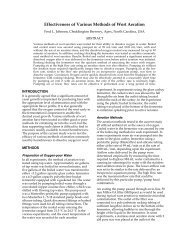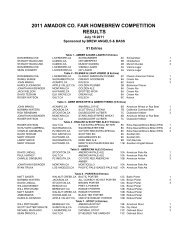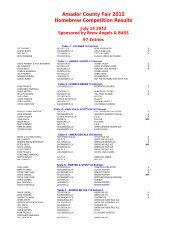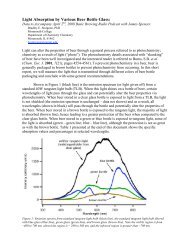A Homebrewer's Guide to Beer Flavor Descriptors - Brew Angels
A Homebrewer's Guide to Beer Flavor Descriptors - Brew Angels
A Homebrewer's Guide to Beer Flavor Descriptors - Brew Angels
Create successful ePaper yourself
Turn your PDF publications into a flip-book with our unique Google optimized e-Paper software.
called fungiform papilla, at the front tip of the<br />
<strong>to</strong>ngue. There are some 3,000 similar protruberances<br />
on the surface of the <strong>to</strong>ngue, each of which is<br />
connected directly <strong>to</strong> the brain by a nerve. ln beer,<br />
the sensation of sweetness ordinarily is impercepable,<br />
or at least of very low intensity, unless the<br />
beer is unbalanced. For that reason, sweetness in<br />
beer often is noted as a flaw.<br />
Sweetness in beer is caused primarily by the<br />
reducing sugars mal<strong>to</strong>se and mal<strong>to</strong>triose, but also<br />
including some glucose and fruc<strong>to</strong>se. Sucrose also<br />
may be present, but it is not a natural constituent<br />
of beer worts; rather it is the result of priming the<br />
beer, or of supplementing the natural wort of<br />
sugars.<br />
Glycerine is another sugar present in finished<br />
beer, and is a direct result of the ferment. In<br />
addition, dextrins are sometimes perceived as<br />
sweet, and in some commercial beers utilizing<br />
enzyme additives, the conversion of dextrins <strong>to</strong><br />
sugars is not halted by pasteurization and the<br />
resulting sugars continue <strong>to</strong> add sweetness <strong>to</strong> beer.<br />
Some fermentation effects may be perceived<br />
as sweetness. These include oxidation or staleness<br />
that may result in a honey perception, and of<br />
course most of the flavors we perceive as fruity<br />
have elements of sweetness in their character.<br />
These include the flavors of apple, banana, black<br />
currant, melon, pear, raspberry and strawberry.<br />
Diacetyl will occasionally be perceived as sweet, as<br />
will caramel and licorice elements. Those can all<br />
be fermentation side effects.<br />
The main source of fermentable extract in<br />
beer is the sugar mal<strong>to</strong>se, C₁₂H₂₂O₁₁, which is<br />
formed from starch by the action of the enzyme<br />
amylase.<br />
The threshold level of sugar detection in a<br />
beverage such as beer seems <strong>to</strong> be from 0.5 <strong>to</strong> 2.5<br />
percent, although the average seems <strong>to</strong> be 1 percent<br />
(by weight) for most folks.<br />
The presence of reducing sugars in beer is<br />
usually complementary <strong>to</strong> the taste, unless they<br />
are present in large amounts. (Reducing sugars<br />
are fermentable sugars that are left over after<br />
fermentation has ceased.) If that happens, then<br />
they may have a negative effect on taste. In most<br />
cases, if the sugar can be perceived at much more<br />
than a threshold sensation, then the beer is defective,<br />
but of course there are exceptions, as in the<br />
case of same strong alas and dark beers, such as<br />
some barley wines.<br />
The most important cause of reducing sugars<br />
remaining in beer is the failure of the yeast <strong>to</strong><br />
fully ferment them. This can be by design of the<br />
brewer, in the selection of lower alcohol‐<strong>to</strong>lerant<br />
yeast, or it may be from exceptionally high original<br />
gravity, also by design of the brewer, used with a<br />
particular yeast strain.<br />
Top‐fermenting yeasts normally have slightly<br />
higher alcohol <strong>to</strong>lerance than bot<strong>to</strong>m‐fermenting<br />
yeasts, and the cold temperature ferments in lager<br />
beer production have the effect of slightly reducing<br />
the fermentability of a wort.<br />
The length of time a yeast is in contact with<br />
the beer is another fac<strong>to</strong>r. All in all, the brewer has<br />
the ability <strong>to</strong> control fermentation and thus the desired<br />
amount of sugar in the final beer. Thus any<br />
perception of sugar that presents itself as “<strong>to</strong>o<br />
much” or “<strong>to</strong>o little” for the style and balance of<br />
beer must be considered a defect.<br />
Finally, alcohol itself contributes <strong>to</strong> our sensation<br />
of sweetness. Sweetness also can mask acidity,<br />
and the presence of just a little common table<br />
salt can enhance the impression of sweetness.<br />
The brewer can control the presence of reducing<br />
sugars by control of mashing times and temperatures,<br />
by the selection of yeast and by the style of<br />
ferment.<br />
Much thanks <strong>to</strong> Kyle Manning and Mark Mecord for their help‐DT SPECIAL ISSUE 1987 ZYMURGY 53






